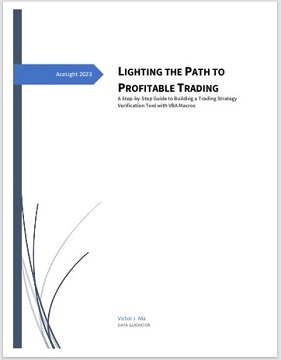Stock Market Secrets:
The Rollercoaster Ride of Trading Strategies and Technical Analysis
|
|
My friend Jim is a senior stock trader, often gets asked the
question, "What's the secret to your success?" And he always gives the same
answer: "Pure luck and a lot of caffeine." But the truth is, there's no
magic formula to making money in the stock market. It's a combination of
research, analysis, and a healthy dose of irrational optimism. One of the
key components to being a successful trader is having a solid trading
strategy. Technical analysis is a crucial tool that traders can use to make
informed trading decisions. In this blog, we will explore some effective
stock market trading strategies and discuss how technical analysis can be
used to identify potential trading opportunities.
1. Trend Following
Strategy
The trend following strategy is a popular trading strategy
among traders. The basic principle of this strategy is to identify the
direction of the market trend and trade in that direction. Traders using
this strategy typically use technical analysis to identify the trend
direction and make trading decisions based on the trend.
One of the
most commonly used indicators to identify the trend direction is the moving
average. The moving average is a technical analysis tool that calculates the
average price of a security over a specific time period. Traders using the
trend following strategy typically use the 50-day and 200-day moving
averages to identify the trend direction. If the price of a security is
above the 50-day and 200-day moving averages, it is considered to be in an
uptrend. Conversely, if the price is below the 50-day and 200-day moving
averages, it is considered to be in a downtrend.
Let's take a look at
an example to better understand the trend following strategy. Suppose a
trader is interested in trading the stock of Company X. After conducting
technical analysis, the trader determines that the stock is in an uptrend as
the price is above the 50-day and 200-day moving averages. The trader
decides to enter a long position and holds the position until the trend
changes.
2. Breakout Strategy
Another popular trading strategy
is the breakout strategy. The breakout strategy involves identifying key
levels of support and resistance and trading the breakout of these levels.
Traders using this strategy typically use technical analysis to identify key
levels of support and resistance.
One of the most commonly used
indicators to identify key levels of support and resistance is the pivot
point indicator. The pivot point indicator is a technical analysis tool that
calculates key levels of support and resistance based on the previous day's
price action. Traders using the breakout strategy typically use the pivot
point indicator to identify key levels of support and resistance.
Let's take a look at an example to better understand the breakout strategy.
Suppose a trader is interested in trading the stock of Company Y. After
conducting technical analysis, the trader determines that the stock is
trading in a range between $50 and $60. The trader identifies the key levels
of support and resistance at $50 and $60, respectively. The trader decides
to enter a long position if the stock breaks above the $60 resistance level
or a short position if the stock breaks below the $50 support level.
3. Contrarian Strategy
The contrarian strategy involves trading
against the prevailing market trend. Traders using this strategy typically
use technical analysis to identify overbought and oversold conditions in the
market. The goal of the contrarian strategy is to enter trades when the
market is at extreme levels and trade in the opposite direction of the
prevailing trend.
One of the most commonly used indicators to
identify overbought and oversold conditions in the market is the relative
strength index (RSI). The RSI is a technical analysis tool that measures the
strength of a security's price action. Traders using the contrarian strategy
typically use the RSI to identify overbought and oversold conditions. An RSI
reading above 70 indicates overbought conditions, while an RSI reading below
30 indicates oversold conditions.
Let's take a look at an example to
better understand the contrarian strategy. Suppose a trader is interested in
trading the stock of Company Z. After conducting technical analysis, the
trader determines that the stock is in an uptrend, but the RSI is indicating
overbought conditions with a reading above 70. The trader decides to enter a
short position and trade in the opposite direction of the prevailing trend.
 For any trading strategy
and indicator, no
matter how good it sounds, we must test it before using it in the real
market. These tests include back-testing and forward-testing. Without proper
testing, trading will turn into guesswork or even worse, gambling. For more details, click
LIGHTING THE PATH TO PROFITABLE TRADING: A Step-by-Step Guide to Building a Trading Strategy Verification Tool with VBA Macros to get the whole tutorial handbook for free! For any trading strategy
and indicator, no
matter how good it sounds, we must test it before using it in the real
market. These tests include back-testing and forward-testing. Without proper
testing, trading will turn into guesswork or even worse, gambling. For more details, click
LIGHTING THE PATH TO PROFITABLE TRADING: A Step-by-Step Guide to Building a Trading Strategy Verification Tool with VBA Macros to get the whole tutorial handbook for free!
And click Free Trial to download strategies testing tools, all for a 30-day Free Trial.
Click on Subscription to order more strategies testing tools to help your stock trading.
Technical Analysis in Stock Trading
Now that we have discussed
some effective trading strategies, let's explore how technical analysis can
be used to identify potential trading opportunities. Technical analysis
involves analyzing historical price and volume data to identify patterns and
trends in the market. Traders can use technical analysis to identify
potential entry and exit points for trades.
One of the most commonly
used technical analysis tools is chart patterns. Chart patterns are visual
representations of price action that can provide traders with important
information about market trends and potential trading opportunities. Some
common chart patterns include:
1. Head and Shoulders Pattern
The head and shoulders pattern is a bearish reversal pattern that indicates
a potential change in trend. The pattern consists of three peaks, with the
middle peak being the highest (the "head") and the two outside peaks being
lower (the "shoulders"). The pattern is complete when the price breaks below
the neckline, which is a line drawn across the bottoms of the two shoulders.
2. Cup and Handle Pattern
The cup and handle pattern is a bullish
continuation pattern that indicates a potential continuation of an uptrend.
The pattern consists of a rounded bottom (the "cup") followed by a small
consolidation period (the "handle"). The pattern is complete when the price
breaks above the resistance level at the top of the handle.
3. Double
Top Pattern
The double top pattern is a bearish reversal pattern that
indicates a potential change in trend. The pattern consists of two peaks
that are approximately equal in height, with a trough in between. The
pattern is complete when the price breaks below the trough.
In
addition to chart patterns, technical analysts also use a variety of
technical indicators to identify potential trading opportunities. Some
common technical indicators include:
1. MACD
The MACD (Moving
Average Convergence Divergence) is a popular technical analysis indicator
used by traders to identify trends and potential buy/sell signals in the
stock market.
When the MACD line crosses above the signal line, it
is considered a bullish signal and may indicate a potential buying
opportunity. On the other hand, when the MACD line crosses below the signal
line, it is considered a bearish signal and may indicate a potential selling
opportunity. Additionally, traders may look for divergences between the MACD
line and the stock price, as this may signal a trend reversal.
2. ADX
The ADX (Average Directional Index) is another popular technical
analysis indicator used by traders to identify trends and determine the
strength of a trend in the stock market.
The ADX is plotted on a
scale from 0 to 100, with values above 25 indicating a strong trend and
values below 25 indicating a weak trend. Additionally, values above 50 may
indicate an extremely strong trend, while values below 20 may indicate a
range-bound market.
3. Bollinger Bands
Bollinger Bands are
volatility indicators that can help traders identify potential breakouts and
breakdowns in the market. The bands are constructed by placing two standard
deviations above and below a moving average.
Remember, when it comes
to trading strategies and technical analysis, there's no one-size-fits-all
approach. What works for one trader may not work for another, no indicator
can guarantee success. As the old joke goes, technical analysis is like a
bikini - it shows a lot, but not everything.
So, while these
indicators can be helpful in identifying trends and potential buy/sell
signals, they should be used in conjunction with other analysis methods and
a healthy dose of common sense. Because let's face it, the stock market can
be unpredictable, and sometimes the best strategy is just to hold on tight
and enjoy the ride!
|


|

Free Tutorial
Share
|
|
|
|